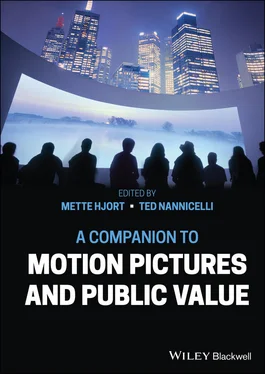A Companion to Motion Pictures and Public Value
Здесь есть возможность читать онлайн «A Companion to Motion Pictures and Public Value» — ознакомительный отрывок электронной книги совершенно бесплатно, а после прочтения отрывка купить полную версию. В некоторых случаях можно слушать аудио, скачать через торрент в формате fb2 и присутствует краткое содержание. Жанр: unrecognised, на английском языке. Описание произведения, (предисловие) а так же отзывы посетителей доступны на портале библиотеки ЛибКат.
- Название:A Companion to Motion Pictures and Public Value
- Автор:
- Жанр:
- Год:неизвестен
- ISBN:нет данных
- Рейтинг книги:3 / 5. Голосов: 1
-
Избранное:Добавить в избранное
- Отзывы:
-
Ваша оценка:
- 60
- 1
- 2
- 3
- 4
- 5
A Companion to Motion Pictures and Public Value: краткое содержание, описание и аннотация
Предлагаем к чтению аннотацию, описание, краткое содержание или предисловие (зависит от того, что написал сам автор книги «A Companion to Motion Pictures and Public Value»). Если вы не нашли необходимую информацию о книге — напишите в комментариях, мы постараемся отыскать её.
A Companion to Motion Pictures and Public Value
Companion
A Companion to Motion Pictures and Public Value
A Companion to Motion Pictures and Public Value — читать онлайн ознакомительный отрывок
Ниже представлен текст книги, разбитый по страницам. Система сохранения места последней прочитанной страницы, позволяет с удобством читать онлайн бесплатно книгу «A Companion to Motion Pictures and Public Value», без необходимости каждый раз заново искать на чём Вы остановились. Поставьте закладку, и сможете в любой момент перейти на страницу, на которой закончили чтение.
Интервал:
Закладка:
A second example of film studies’/screen studies’ (more or less explicit) engagement with issues of public value is research devoted to radical film culture, including radical filmmaking and the practices of exhibition and distribution that support it. Countless are the authors and filmmakers who warrant more than a brief mention in the context of a discussion of radical film culture. For present purposes, however, it suffices to make reference to a recent relevant intervention in the area, Contemporary Radical Film Culture: Networks, Organisations and Activists , edited by Steve Presence, Mike Wayne, and Jack Newsinger (2020). The collaborative project finds its inspiration in the Radical Film Network. Established in 2013, the Radical Film Network is an organization that promotes radical filmmaking and radical film culture on a global basis. The global remit of this institutional source of inspiration is amply reflected in the volume’s various chapters, which jointly span Africa, Asia, China, Europe, the Middle East, as well as the Americas. In Hjort’s (2020) contribution, the issue of public value is explicitly evoked in connection with the features of activist film culture on the African continent. Hjort cites Mbye B. Cham’s evocation of a Fulani saying about art to describe one of the central tenets of activist filmmaking in Africa: “It is entertainment, it is educational and it is functional,” for “African cinema is integral to the wider social and collective effort on the part of Africans to bring about a better life for the majority of Africans” (Cham 1996, 4; cited in Hjort 2020, 101–102). Making reference to filmmaker Gaston Kaboré’s socially transformative talent development initiatives in the context of the alternative film school Imagine in Burkina Faso, to the rights- and social change-oriented priorities of the Zanzibar International Film Festival, to Kenyan Judy Kibinge’s social justice filmmaking, and to Cameroonian Jean-Marie Teno’s tireless commitment to filmmaking on behalf of truth, justice, and change, Hjort makes the point that African filmmakers offer the world a conception of filmmaking that is a precious ressource and genuine “source of public value” (Hjort 2020, 101). Imbued with entertainment, educational, and functional (or instrumental) value, as Mbye Cham would have it, African filmmaking often features a desire to effect change for the benefit of an entire community or public. Often neglected or marginalized in the more resource-intensive production milieux of the Global North, this understanding of the role played by moving images within the dynamics of community formation, nation building, and the construction of good societies is part of the normative impetus for A Companion to Motion Pictures and Public Value .
As in the case of useful cinema, the radical film culture paradigm invites questions about the public value of the cinema’s moving images, but does not explicitly establish a framework for the necessary considerations. Cited in the context of a discussion of activist filmmaking, Mbye Cham’s references to entertainment, education, and function suggest some of the many values that may be pursued through filmmaking and the wider institutional practices that sustain it. But what of other values that might be mediated by motion pictures? And how do various values relate to each other? How exactly are we to draw a line, even a fuzzy one, between values that somehow count as private as compared with public?
Our last example of a field of film studies/screen studies research that relies on intuitions about public value is that of small nation film studies (Hjort 2005; Hjort and Petrie 2007; Thomson 2018), especially as it relates to state-supported film industries. The history of state support, for example in the small nordic nation of Denmark from around 1960 onwards, is largely one of developing strategies and policies aimed at creating the conditions for a thriving film industry that can serve the public good. A key underlying premise is that in the absence of state support, filmmakers, and producers, facing punishing levels of global competition (Bondebjerg n.d.), would come to see filmmaking in and about the small nation as unsustainble. State funding, in effect, is about mitigating the systemic risks that are a feature of the terrain of small nation filmmaking (Hjort 2015). Justifications for state funding make reference to film as art, but often what is especially salient is the cultural, social, or political value that is to be derived from cinematic works reflecting the language, culture, history, and diversity of everday life in the small nation in question. Cinematic output of a certain volume and genre-based scope is seen as a necessary element in the preservation and further development of the various elements that make up a national culture. Also important are the ways in which filmmaking within and about the national space nurtures the self-understandings of viewers qua citizens and, furthermore, facilitates national conversations about matters of collective significance.
Reflecting on the defining tenets of nordic media studies, Kirsten Drotner (2020, np) foregrounds two notions: “One is a welfarist definition of culture as a common good and not, or not merely, as a commodity on a competitive market. […] The other notion […] is the definition of media as forms of culture in […] a legal, economic, organisational and social sense.” The welfarist definition (see also Syvertsen and Enli 2014) is seen as yielding a conception of cultural institutions as serving all citizens, including through a “diversity of cultural output and outlets.” The definition of film and other media as forms of culture has the effect of making them a source of “public value and not, or not merely” a source of “private gain” for investors. The welfarist and cultural definitions of film and other media, claims Drotner, are core elements in a public service paradigm that continues to be of great relevance. More specifically, this paradigm is shaped by ideals that are essentially normative (in the sense of contributing to what ought to be the case), thereby offering “a much-needed critical and ethical corrective” (Drotner 2020) to tendencies that eschew (explicitly) normative thinking about the whys and wherefores of cultural production.
Aims
A Companion to Motion Pictures and Public Value finds a starting point in a discernible film-related deficit in many government-driven discussions, reports, and conferences devoted to the value of culture, especially in the United Kingdom and the small nordic nations. Let us look at an example. In 2011 the University of Turku, Finland, organized a conference entitled “Culture, Health, and Well-being” in the context of the city’s successful bid for the status of European Cultural Capital that year. The point of this well organized, carefully designed, and forward-looking interdisciplinary conference was to bring together scholars, civil servants, and creative practitioners to explore the ways in which culture contributes to health and well-being. Music featured prominently in the discussions, as did theatre, dance, and the visual arts. Motion pictures, on the other hand, were less well represented, just as research related to the positive contributions of motion pictures to health and well-being was generally seen, quite rightly so, as substantially less developed than undertakings in a field such as music for health and well-being.
Health as a public value relates not only to the health-promoting results of practitioners’ efforts, to the music that emerges from the musicians’ playing or to the film that results from the coordinated work of a film crew, but also to the practitioners themselves. Here too, a glaring deficit is immediately discernible when comparisons between music studies and screen studies are undertaken. The public value of safeguarding and nurturing musicians’ health is well recognized—among other things through the development of health education for musicians (Matei et al. 2018) and the elaboration of substantial wellness-oriented guides to practice (Klickstein 2009). Filmmakers’ health, on the other hand, is a field that has yet to emerge in even the most preliminary of ways, a fact that was clearly evidenced by the program of the Turku conference which featured musicians’ (and dancers’) health prominently and left the reality of filmmakers’ health untouched.
Читать дальшеИнтервал:
Закладка:
Похожие книги на «A Companion to Motion Pictures and Public Value»
Представляем Вашему вниманию похожие книги на «A Companion to Motion Pictures and Public Value» списком для выбора. Мы отобрали схожую по названию и смыслу литературу в надежде предоставить читателям больше вариантов отыскать новые, интересные, ещё непрочитанные произведения.
Обсуждение, отзывы о книге «A Companion to Motion Pictures and Public Value» и просто собственные мнения читателей. Оставьте ваши комментарии, напишите, что Вы думаете о произведении, его смысле или главных героях. Укажите что конкретно понравилось, а что нет, и почему Вы так считаете.












